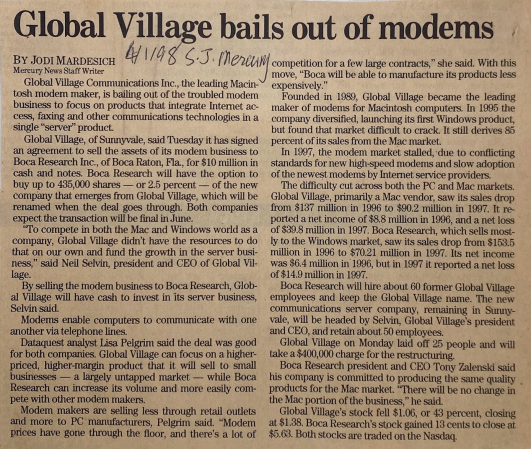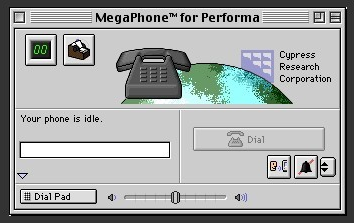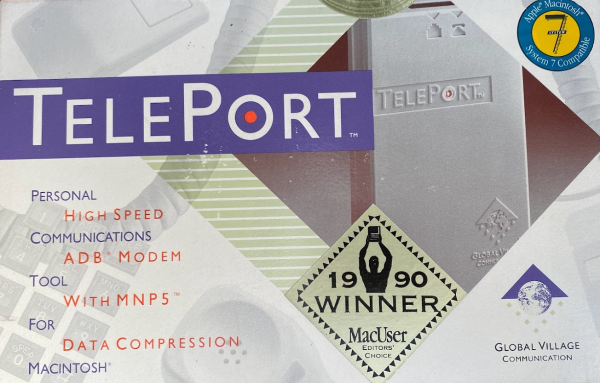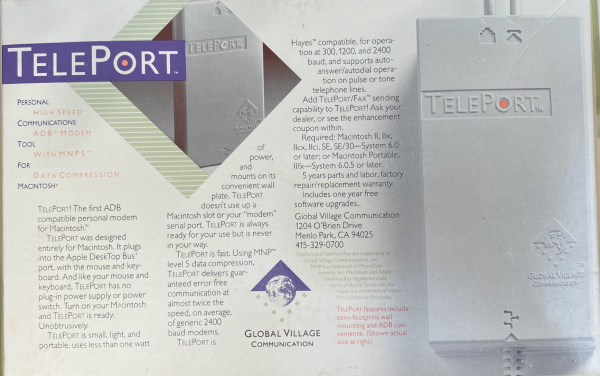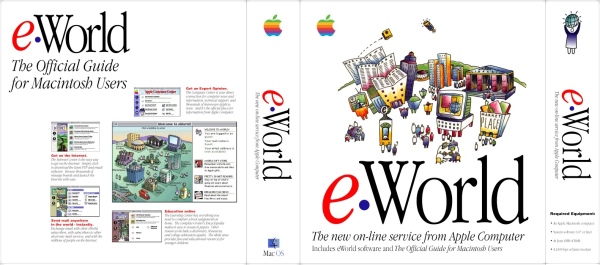I have been saving this post for this day because it is a special day, the anniversary of my experiencing the Silicon Valley dream; the IPO! Been there, done that, and literally got the T-shirt. What else can I say? Well, a lot of things it seems.
30 years ago today Global Village went public and was availble for trading on the NASDAQ exchange under the GVIL ticker.
Everybody who worked at Global Village on that day got one of those T-shirts. Mine has been sitting in a frame for more than 20 years now. It used to be on the wall in my office at work, back when I was important enough to warrant an office, and it has sat in my home office since then.
Stock options and going public are the things that Silicon Valley dreams are made of… though being bought out by Google used to come pretty close on that front. There are legendary tales of invididuals who got in early, worked hard with the promise of their stock options being worth something some day, and who were able to retire when the magic moment hit. (And equally legendary tales of people who gave up their shares only to later find that they have abandoned riches.)
There is a long standing story of old hands at Microsoft with stickers on their badge reading “FYIFV,” which stood for “fuck you, I’m fully vested” meaning that they could take the money and run any time they pleased.
I know people who have hung around Apple for ages who are worth millions due to stock options they were given over the years, especially options handed out at very low valuations during the bad days between Scully and the return of Steve Jobs.
My story is perhaps less dramatic. It is certainlty less lucrative.
When I started in tech support at Global Village in 1992 I made $28K annually, was given 2,500 options valued at 25 cents each, that being the estimated value of shares when I was hired, and the choice of a better computer if I opted to sit in an interior cube versus a window cube.
And you only need to look out the window if your computer is slow, right?
As with most people, my stock options vested over time. For some reason they decided to set the vesting period for five years, so after working there a year 500 shares would be available for me to purchase at the initial valuation. I would then accrue more shares on a monthly basis until I hit five years, at which point I would be fully vested.
Most places considered four years enough, but somebody at GV got five years in the head. Later, when I moved on to Big Island I complained to Rick that I was going to have to leave behind more than 500 shares of stock because I wouldn’t be fully vested until mid-1997. The stock still had value then. By 1997 it has lost much of it.
As I worked my way out of support and upstairs into engineering, the company was harnessing its success and building towards going public. One of the things that happened was the VCs started putting people in place to run the company, people who would follow their instructions for preparing the company for an IPO.
Our CEOI was one of the marketing executives from Apple who were on the PowerBook project, and the CFO… I forget where he was from, though I recall he later left in disgrace due to some ethical lapse.
But that wouldn’t make him alone in the board room I guess.
We needed two things to go public back then. The first was that we had to have two successful product lines. We already had the Macintosh modem market sewn up pretty well. But modems were all viewed as a single product line. That was where the OneWorld network fax, modem, remote access server line came in.
It didn’t have to be super successful, it just had to prove that we had two product lines.
Then we had to show a continuous pattern of growth. This meant that every quarter had to exceed the past quarter for revenue. That mean cutting off some quarters early when we had made enough revenue in order to carry it forward into the next.
This was, of course, unethical and probably unlawful. But our CEO told us they were doing it at a company meeting, so it isn’t like they were hiding it.
And, of course, we had to be profitable. But that was no problem. The Mac modem market was lucrative, the PowerBook segment especially.
This all changed not too far down the line. The rules changed when the VCs decided they wanted to cash out on Netscape about a year and a half later. Netscape didn’t need to make money or have a long term plan, they went public on hype and a pomise that there must be SOMETHING of value in the company because we were all using the Netscape Natigator browser… you were supposed to pay for it, but almost nobody did… and a company that had something on damn near everybody’s computer had to be wise and powerful.
It set the pattern for the dotcom boom, the idea that you just had to have a lot of users, that butts in seats, as it was called, was more important that making a profit or having a business plan that made any sense.
I happened to live at an apartment at Whisman and Middlefield Road, at one end of the series of buildings that would soon have the Netscape name on them. They, somewhat ironically, even had the old Cisco Systems building on Middlefield, a company that was the target model for many startups in the 90s.
As sure as Marc Andreesen provided the spark that made Netscape possible, he also provided most of the very dumb ideas that kept it from being anything beyond a brief flash in the pan. If Steve Case, head of AOL, hadn’t been a sucker, hadn’t believed the hype, he might have saved himself the effort of dismantling the failure that was Netscape rather than buying it in 1998. Instead he bailed out Andreesen and made him even richer. Case was smart enough to only buy Netscape with AOL stock, and he managed to turn around and sell AOL to Time Warner in 2000, so he wasn’t a complete chump.
Anyway, if you see me dismissing Marc Andreesen as somebody who was simply in the right place at the right time, I submit as evidence pretty much everything he has done since the Netscape IPO… and doubly so that he and his current firm are all in on crypto, though they clearly want to be the scammer in that equation, the rent seeking landlord, the house that wins no matter what happens.
But I digress.
So the day came, February 24, 1994, and Global Village went public. GVIL was listed on NASDAQ. I think the CEO got to ring the opening bell on Wall Street that day. We were all going to be rich!
Right? RIGHT?
Well, no. Or maybe. I certainly was not.
The stock opened up at $8 a share. If I had been able to exercise and sell ALL my shares on that date, it would have been worth $20,000. That wasn’t going to buy me a house, much less let me retire, even in 1994. But it could have been a down payment on a nice condo.
Except, of couse, I couldn’t sell all of my shares on that day. I had only hit about a year and a half of vesting, so I only had some shares available. 791 I think.
But still, if I could sell those, it would still net me more than $6K after fees and such.
I could not, however, sell ANY shares because when a company does an IPO employee shares are generally locked out from being sold for a period of time in order to let the VCs and other favored investors cash out in the initial frenzy. We had to wait six months.
And in six months, after the big cash out, the stock was down to $5 a share. That was even less interesting than $8 a share. But our time was not done yet.
The inetrnet was becoming a thing. While I disdained Netscape just a few paragraphs back, a company with no plan and no proven track record that went public on hype alone, the hype was not reserved for Netscape alone.
The market itself was rising. We were past the post Cold War recession, the peace dividend was a thing, Bill Clinton was president, and the internet in general and the World Wide Web in particular were suddenly the most interesting thing for Wall Street. We all wanted to get online, to the point that I wrote about the great dial tone drought a while back. Netscape was a symptom, not a cause of the hype, and any company that was involved with getting online was suddenly viewed with a great fondness beyond anything Lord British ever felt. (If anybody gets that call back reference I will be amazed.)
Among the beneficiaries was GVIL, which was pulled out of its $5 doldrums and began to rise with the internet tide. It passed $8, then $12, then $16 a share. Maybe we would be rich!
The price peaked just past $21 a share at one point. I remember this vividly as I had my shares with a broker and the day it hit that I put in a sell order. I could have sold at market, which would have just gotten me the money. That was in early 96 I think, which would have given me nearly 2,000 shares to play with. That many shares at $20… well, again, I wasn’t going to be rich, but that was a down payment on a real house or maybe a new car paid for in cash, with money set aside for the taxes on the sale.
But I did not put in the sell order at market price. I put it in at $22 a share to eke out just a little bit more cash. And it never got there. I then chased the price down the drain for the next two years. I would set a sell order at a price… because it wasn’t in constant decline, it would bounce back up a bit, before settling down to a lower plateau than before… hoping to catch an uptick, only to have the price drop, never to return.
It fell through $18, $12, $10, $8, $5 and was mucking about around $4 a share, at which point I was hardly paying attention. The modem market had collapsed… modems were becoming a commodity and Apple was at its nadir, that period when it was bouncing around between $12 and $18 a share, when Michael Dell was quipping about the company just giving them investors their money back and calling it a day… and Global Village sold off its modem business and its name.
By that point Big Island was in its own spiral and I was a Cypress Research and had an offer from a company called Edify, that would change my path into enterprise software.
The company became One World, and its stock ticker changed to OWLD. Lots of grandious promises were made and hamfisted attempts to create a pump and dump scam out of the stock were rife in the Yahoo finance forum for the stock.
I sold most of my stock before it turned to OWLD at somewhere around $3 a share. I went from a new BMW to a new PC in value. And I didn’t even sell all of it. Before the pre-IPO I had exercised my first vesting of shares. I have a stock certificate for 500 shares of Global Village in a drawer with my name on them.
Exercising shares before the IPO was a dumb thing to do, and I blame my youthful ignorance and enthusiasm for this lapse. When you buy shares like that, before the IPO, they become directly registered shares. You may have heard reference to directly registered shares as part of the dumbassery around the GameStop stock bubble, where the amateur investors, the “apes,” built up a whole fantasy around direct restistered shares. (If you haven’t heard about that, Folding Ideas has an excellent video about the whole thing. Worth watching, or at least listening to.)
The reality is that such shares are just a pain in the ass to sell because you have to do transactions through physical mail, with all the delay that incurs, to do anything with them. By the time I wanted to do something with them, the stock was already sinking.
Meanwhile, the company stayed in steady decline. OWLD would fall below $1 a share, with delisting threatened, before the company folded up shop in 1999.
It could have been worse. The story was one of the early hires held onto their 25,000 shares until the place went out of business. They believed in the company, and emotional investment in something like a tech company is never a good idea.
But I did learn my lesson. When I took my vested Edify options… a merger caused them all to vest early, which changed the ticker to SONE, a company we’ll get to later… and sold them because my wife and I wanted to buy a house. I set a sell order at market value and cashed them all out at $130 a share. The stock closed over $131, and touched close to $134 before the bell that day, at what was the absolute peak of the dotcom boom. It was literally the bubble just before it burst. I was a bit disappointed that I had sold below the days high and wondered if I had called in too early, if the next day would see the market climb even higher.
It did not. The next day the stock fell to $128. And it fell a bit more the day after that, and more every day for many days to come. I had the good fortune and amazing luck to have sold at just a couple of bucks below its ultimate peak price point. We bought the house and, as it turns out, buying real estate in Silicon Valley in 2000 had a better return than most investments.
Nobody has ever offered me stock options again. It stopped being as much of a thing after the dotcom bubble. Taxes and accounting laws were tightened up and the executives decided that only they deserved stock options for all of their hard work.
I closed my brokerage accounts and have not since invested directly in any stock, avoiding anything like the stock purchase plans that some companies have offered now and then, where twice a year they buy stock for you with money they have held back from your paycheck at the market price less a discount for being in the program… usually 15%.
And at every buy date the stock in question would spike up, much more than the 15% discount, and then fall back the next day, ensuring that the whole thing was a screw job for those who bought in on it.
I have money in a 401k for retirement, in an index fund. But investing in stock as an individual retail customer with an eye towards increasing your money… that is just gambling. And, as with any form of gambling, the house wins and the individuals lose. The index fund is only allowed to “win” because somebody on Wall Street earns their bonus based on that. You’re allowed to win a bit while they win big… though somehow they win big even when you lose.
I’d like to say it wasn’t always like that. But then I think about the 1920s and the great depression that the market caused while people like Joe Kennedy got rich. Even in the calm periods, where the market seemed focused on dividends and stability, the house always won in the end.
The story so far:
- Hanging on the Telephone
- Calling the Mall
- Finding Friends with the Popcorn Lady
- Jenny and the FCC
- What Your Area Code Used to Say About Your Location
- I Get a Modem then Start a BBS
- Tech Support at the Village
- Dominating the PowerBook Modem Market
- The Death of eWorld
- The Great Dial Tone Drought of 96
- When the Modem Business Ran Out at the Village
- The Village Attempts to Move Beyond Modems
- Anecdotes from the Village
- Usenet Newsgroups Part I – I find some Usenet Archives on CD-ROM
- Usenet Newsgroups Part II – What is on that CD and Why Your Hard Drive isn’t a Database
- Usenet Newsgroups Part III – Founding, Fame, Influence, and Foreshadowing
- From the Village to the Island
- YoYo Mechanic
- The Great Failure of Residential ISDN in the US Market
- Set Adrift from the Island



